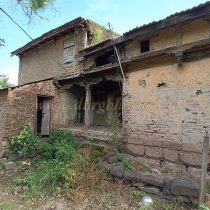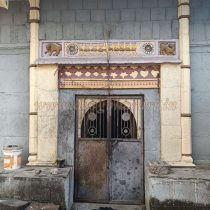CHARHOLI
TYPE : NAGARKOT / GADHI
DISTRICT : PUNE
HEIGHT : 0
While wandering around the city of Pune, we get to see numerous fortress and wada (huge mansion) along with some city forts. Charholi Budruk of Tapkir Patil is one of them. At Charholi Budruk village in Haveli taluka of Pune district, we can see two wada of Sardar Tapkir Patil as well as Nagarkot which surrounds the village. The growing urbanization in Pimpri-Chinchwad has reached this village and urbanization has taken away all these monuments. Charholi Budruk village is 15 km from Pimpri city. Dnyaneshwar Mauli's memorial is at a distance of 5 km from Alandi. Charholi Budruk and Charholi Khurd are situated on two sides of Indrayani River and Charholi Budruk is famous as Tapkir Patil’s village. While entering the village, we get to see the forts gate at the entrance of the village.
...
The wooden doors are still in good condition and do not show any kind of protective structure like bastions around it. Four-wheeled vehicles can easily come and go through this spacious door with guard room on both sides inside the door. Apart from this door, no other remains of fort remain today. After entering through this door, a little further and turning left, we reach the Bhairavanath temple. Near this temple was the wada of Tapkir till the very recent times i.e. till 2010. This mansion belonged to Dulbazi Tapkir Patil and it was known as Gawloba's mansion. The wada has now been completely destroyed and new buildings have been erected in its place. The only remnant of this wada now is the temple of Bhairavanath. The arch of the door of this temple, which is completely built of folded stone, has tiger and other sculptures carved on it. The auditorium of the temple rests on a circular arch and its roof is also like a dome. As there is nothing left except the temple, after seeing it, go straight and turn right, there is another wada of Tapkir Patil. This wada inside the ramparts is still standing and nobody lives in it as it is deserted. So it is also a companion of short time until it collapses. The lower half of the rampart surrounding the fort is made of stone and the upper half is made of bricks. The arch of the door in this fort is completely built with bricks. Locals say that there were once three gates in this fort, but this is the only one remaining today. Inside the fort there are many open spaces and in the centre is a two-storied wada of Tapkir Patil. The foundation of the wada is built with stones and the construction on it is done with bricks and plastered with lime and mud. Looking at the overall structure of the wada, it seems that it should be of pre-Peshwa period. The place in front of the wada has a small amount of carving on the woodwork. As the wada is deserted, it is dangerous to walk inside. This place belongs to Barwaji Tapkir Patil and is known as “Madhala wada”. Apart from this one more wada can be seen in front of Ganapati temple on the banks of Indrayani River but it is not possible to say whose it is. One hour is enough to visit Charholi village. A document belonging to the family of Honap Deshpande mentions that Tapkir Patil family owned Patilki since 1610 AD. A letter dated 1695 records that Patilki of Charholi village was in this family. While Chhatrapati Rajaram Maharaj at chandi ordered the Deshadhikari Pargana Pune to summon Dulbazi and Barwaji (Tapkir) as he had been rewarded with two square pieces of land for Patilki. The land was given by inheritance and ordered not to expect a new letter every year. It is stated that "Nanasaheb Peshwa went to Charholi in 1750 AD. From there they went to Chikhli, Patil Devji Tapkir of Charholi village met the Peshwa (Tuesday 2nd Kartik 1672). During the Peshwa period in Maratha history, Devjirao of the Tapkir Patil family became a very accomplished man. His cavalry squad was special. A mention of it is found in a letter written by Raghobadada to Nanasaheb Peshwa. "Further, Malhar Naik and Nagoram Bapuji and Devji Tapkir and Savaji Borge and Manaji Shinde sent off with a squad of 4,000 troops along with this squad. If Mughals are found, they will either defeat him or turn around. (Shake 1685, Magh Shukla 13 ).
© Suresh Nimbalkar















